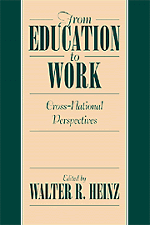Book contents
- Frontmatter
- Contents
- Contributing Authors
- Preface
- Introduction: Transitions to Employment in a Cross-National Perspective
- Part I Social Origin, Gender, and Transition Patterns
- 1 Social and Geographical Mobility 20 Years after High-School
- 2 Diverse Directions: Young Adults' Multiple Transitions
- 3 New Routes to Employment: Integration and Exclusion
- 4 From Education to Employment: Occupations and Careers in the Social Transformation of East Germany
- Part II Education and Labour Markets: Work Experiences, Skills, and Credentials
- Part III Changes in the Social Context of Transitions
- References
- Index
3 - New Routes to Employment: Integration and Exclusion
Published online by Cambridge University Press: 30 September 2009
- Frontmatter
- Contents
- Contributing Authors
- Preface
- Introduction: Transitions to Employment in a Cross-National Perspective
- Part I Social Origin, Gender, and Transition Patterns
- 1 Social and Geographical Mobility 20 Years after High-School
- 2 Diverse Directions: Young Adults' Multiple Transitions
- 3 New Routes to Employment: Integration and Exclusion
- 4 From Education to Employment: Occupations and Careers in the Social Transformation of East Germany
- Part II Education and Labour Markets: Work Experiences, Skills, and Credentials
- Part III Changes in the Social Context of Transitions
- References
- Index
Summary
No clear or strong relationship can be evidenced between qualifications and employer needs. Deficiencies are noted in relevance, access responsiveness, flexibility and cost effectiveness. Some are apparently attributable to the structure of qualifications, others to the content. The studies do not reveal distinct major and minor occupations, nor distinct vertical hierarchies. Level of qualifications is predominantly relevant in recruitment and selection. It seems to become an issue for employers only when it interferes with utilization and supply (Pearson & Marshall, 1996).
This quotation from a recent report on skills utilization by British employers indicates how loosely the system of vocational preparation in Great Britain (Vocational Education and Training, or VET) and the certification it produces is linked to labor-market demands. In line with what social-exclusion theorists tell us about the employment value of qualifications and skills (e.g., Collins, 1979), British employers appear to use qualifications more as a means of sifting young job applicants in terms of the broad abilities associated with educational attainment, as much as by their accredited skills. Thus, academic qualifications, with no direct relevance to employment, are often prized over vocational qualifications and the certification produced by youth training because of the personal qualities they are perceived to signify in the individuals who possess them.
- Type
- Chapter
- Information
- From Education to WorkCross National Perspectives, pp. 65 - 86Publisher: Cambridge University PressPrint publication year: 1999
- 13
- Cited by



